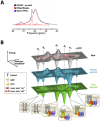New Horizons in Structural Biology of Membrane Proteins: Experimental Evaluation of the Role of Conformational Dynamics and Intrinsic Flexibility
- PMID: 35207148
- PMCID: PMC8877495
- DOI: 10.3390/membranes12020227
New Horizons in Structural Biology of Membrane Proteins: Experimental Evaluation of the Role of Conformational Dynamics and Intrinsic Flexibility
Abstract
A plethora of membrane proteins are found along the cell surface and on the convoluted labyrinth of membranes surrounding organelles. Since the advent of various structural biology techniques, a sub-population of these proteins has become accessible to investigation at near-atomic resolutions. The predominant bona fide methods for structure solution, X-ray crystallography and cryo-EM, provide high resolution in three-dimensional space at the cost of neglecting protein motions through time. Though structures provide various rigid snapshots, only an amorphous mechanistic understanding can be inferred from interpolations between these different static states. In this review, we discuss various techniques that have been utilized in observing dynamic conformational intermediaries that remain elusive from rigid structures. More specifically we discuss the application of structural techniques such as NMR, cryo-EM and X-ray crystallography in studying protein dynamics along with complementation by conformational trapping by specific binders such as antibodies. We finally showcase the strength of various biophysical techniques including FRET, EPR and computational approaches using a multitude of succinct examples from GPCRs, transporters and ion channels.
Keywords: EPR; FRET; HDX-MS; NMR; X-ray; antibody fragments; cryo-EM; membrane protein dynamics; membrane protein structure; membrane proteins.
Conflict of interest statement
The authors declare no conflict of interest.
Figures







Similar articles
-
Frozen motion: how cryo-EM changes the way we look at ABC transporters.Trends Biochem Sci. 2022 Feb;47(2):136-148. doi: 10.1016/j.tibs.2021.11.008. Epub 2021 Dec 17. Trends Biochem Sci. 2022. PMID: 34930672 Review.
-
Identifying and Visualizing Macromolecular Flexibility in Structural Biology.Front Mol Biosci. 2016 Sep 9;3:47. doi: 10.3389/fmolb.2016.00047. eCollection 2016. Front Mol Biosci. 2016. PMID: 27668215 Free PMC article. Review.
-
Iterative Molecular Dynamics-Rosetta Membrane Protein Structure Refinement Guided by Cryo-EM Densities.J Chem Theory Comput. 2017 Oct 10;13(10):5131-5145. doi: 10.1021/acs.jctc.7b00464. Epub 2017 Sep 26. J Chem Theory Comput. 2017. PMID: 28949136 Free PMC article.
-
Integrated structural biology to unravel molecular mechanisms of protein-RNA recognition.Methods. 2017 Apr 15;118-119:119-136. doi: 10.1016/j.ymeth.2017.03.015. Epub 2017 Mar 16. Methods. 2017. PMID: 28315749 Review.
-
Structure Determination by Single-Particle Cryo-Electron Microscopy: Only the Sky (and Intrinsic Disorder) is the Limit.Int J Mol Sci. 2019 Aug 27;20(17):4186. doi: 10.3390/ijms20174186. Int J Mol Sci. 2019. PMID: 31461845 Free PMC article. Review.
Cited by
-
Computational drug development for membrane protein targets.Nat Biotechnol. 2024 Feb;42(2):229-242. doi: 10.1038/s41587-023-01987-2. Epub 2024 Feb 15. Nat Biotechnol. 2024. PMID: 38361054 Review.
-
A Tiny Viral Protein, SARS-CoV-2-ORF7b: Functional Molecular Mechanisms.Biomolecules. 2024 Apr 30;14(5):541. doi: 10.3390/biom14050541. Biomolecules. 2024. PMID: 38785948 Free PMC article.
-
Structure-Based Function and Regulation of NCX Variants: Updates and Challenges.Int J Mol Sci. 2022 Dec 21;24(1):61. doi: 10.3390/ijms24010061. Int J Mol Sci. 2022. PMID: 36613523 Free PMC article. Review.
-
Solution NMR investigations of integral membrane proteins: Challenges and innovations.Curr Opin Struct Biol. 2023 Oct;82:102654. doi: 10.1016/j.sbi.2023.102654. Epub 2023 Aug 3. Curr Opin Struct Biol. 2023. PMID: 37542910 Free PMC article. Review.
-
Fundamentals of HDX-MS.Essays Biochem. 2023 Mar 29;67(2):301-314. doi: 10.1042/EBC20220111. Essays Biochem. 2023. PMID: 36251047 Free PMC article. Review.
References
-
- Pervushin K., Riek R., Wider G., Wüthrich K. Attenuated T2 relaxation by mutual cancellation of dipole-dipole coupling and chemical shift anisotropy indicates an avenue to NMR structures of very large biological macromolecules in solution. Proc. Natl. Acad. Sci. USA. 1997;94:12366–12371. doi: 10.1073/pnas.94.23.12366. - DOI - PMC - PubMed
Publication types
LinkOut - more resources
Full Text Sources

